Waimea Canyon State Park
- December 22, 2023
- 0 comment
Waimea Canyon State Park emerges as a striking testament to the awe-inspiring beauty of nature. Located in verdant island of Kauai. Affectionately known as the “Grand Canyon of the Pacific,” this captivating destination unfolds over 14 miles, revealing a vibrant tapestry of colors and textures that stretch more than 3,600 feet deep. Carved by the relentless forces of the Waimea River, fueled by the abundant rainfall from the island’s central peak, Mount Waiʻaleʻale, Waimea Canyon is a geological masterpiece. Its ochre-red cliffs and lush greenery create a breathtaking panorama that evolves throughout the day, urging visitors to explore its wonders during the tranquility of early mornings or under the spell of a rainbow-draped sky in the summer.
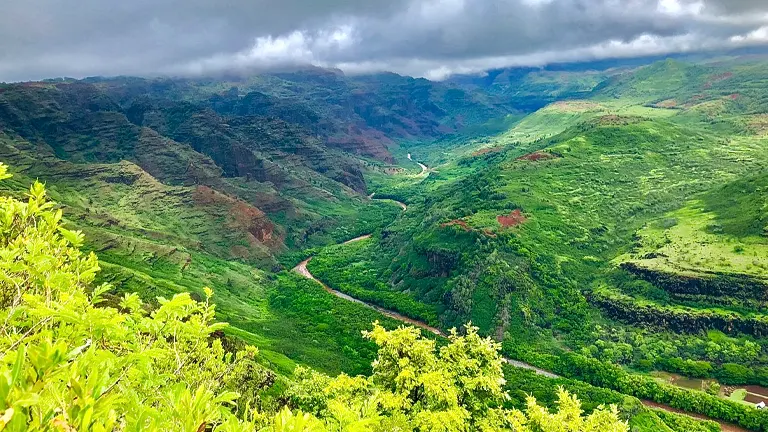
Beyond its visual splendors, the park beckons adventurers with scenic drives, panoramic viewpoints, and a network of hiking trails that wind through its 1,866 acres of pristine wilderness. Whether on foot, by bike, or soaring high on a helicopter ride, Waimea Canyon State Park promises an immersive experience, inviting all who venture there to witness the timeless beauty etched into the heart of Kauai’s landscapes.
Characterizing Features of the Waimea Canyon State Park
- Breathtaking Depths and Length: Waimea Canyon, often dubbed the “Grand Canyon of the Pacific,” extends over 14 miles and plunges to depths exceeding 3,600 feet. The canyon’s vast dimensions offer visitors a sense of scale that is both humbling and awe-inspiring.
- Geological Marvel: Carved by the Waimea River, originating from Mount Waiʻaleʻale, one of the wettest places on Earth, the canyon showcases the island’s complex geological history. The erosion of red soil gives the canyon its distinctive color, while the tholeiitic and post-shield calc-alkaline lavas reveal evidence of significant faulting and collapses in Kauai’s early history.
- Ever-Changing Colors: The canyon’s appearance can vary throughout the day, with vibrant red hues transitioning under different lighting conditions. Early morning visits are recommended for a quieter experience and enhanced visibility, while the summer months may treat observers to the magical sight of rainbows.
- Scenic Drives and Panoramic Lookouts: Accessible via a scenic drive along Hawaii state road 550, the park offers a picturesque journey leading to various panoramic lookouts. These vantage points provide stunning views of the canyon’s vast expanse, allowing visitors to appreciate its beauty from different perspectives.
- Diverse Hiking Trails: Encompassing 1,866 acres, Waimea Canyon State Park features numerous hiking trails catering to various skill levels. Whether opting for a leisurely stroll or a more challenging hike, visitors can immerse themselves in the park’s wilderness and discover hidden gems along the way.
- Unique Geological History: The canyon’s formation is not only a result of gradual erosion but also involves a catastrophic collapse of the volcano that created Kauaʻi. This distinct geological history adds an extra layer of fascination to the park’s narrative.
- Touring Options: Beyond traditional exploration, visitors can experience the canyon in different ways, such as embarking on a bike tour or enjoying a helicopter ride that provides a breathtaking aerial perspective of the canyon’s vastness.
- Striking Contrasts: The canyon’s west side features thin, west-dipping lavas, while the east side boasts thick, flat-lying lavas. The stark contrast is a result of an enormous fault along which a significant part of the island moved downwards in a colossal collapse, shaping the unique topography of the canyon.
- Natural Wonders in Surroundings: The park offers glimpses of Niʻihau, the “Forbidden Isle,” located just west of Kauaʻi. The proximity allows visitors to enjoy additional scenic views of this neighboring island from the park’s highways.
- Tranquil Mornings and Limited Crowds: To maximize the experience, visiting Waimea Canyon State Park early in the morning is recommended. The quieter atmosphere allows for a more intimate connection with the surroundings and better opportunities for uninterrupted appreciation of the breathtaking scenery.
History
Waimea Canyon State Park’s rich history is etched into the geological tapestry of Kauai, Hawaii. Formed over millions of years, the canyon’s origins lie in the volcanic activity that shaped the Hawaiian Islands. Approximately 4 million years ago, a portion of the island, then continuously erupting, experienced a colossal collapse, creating a depression that would later become Waimea Canyon. As rainwater from Mount Waiʻaleʻale, one of the wettest spots on Earth, began to erode the canyon’s edges, it exposed basalt cliffs that transformed over time from their original black to the vibrant red hues that define the canyon today.
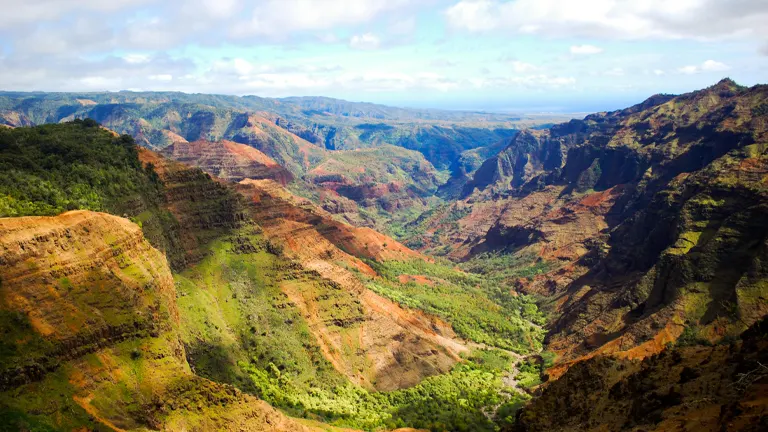
The unique geological history of Waimea Canyon involves both the gradual erosion process and a catastrophic collapse, setting it apart as a testament to the dynamic forces that have shaped Kauai’s landscape. Over the years, the canyon has become a revered natural attraction, drawing visitors to witness its breathtaking beauty and unravel the geological narrative that unfolds within its vast expanse.
Importance in Conservation and Recreation of Waimea Canyon State Park
Waimea Canyon State Park holds a dual significance in both conservation and recreation, making it a cherished gem on the island of Kauai. Conservationally, the park serves as a living testament to the geological evolution of the Hawaiian Islands. The unique topography of Waimea Canyon, with its layered rock formations and the vivid contrast between the east and west sides, offers valuable insights into the island’s complex geological past. The park’s diverse ecosystems provide a habitat for a variety of plant and animal species, contributing to the overall biodiversity of the region. In terms of recreation, Waimea Canyon is a haven for outdoor enthusiasts and nature lovers.
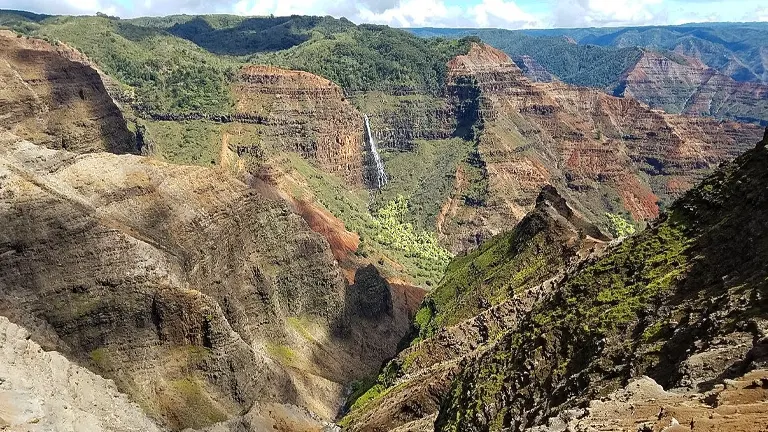
Its extensive network of hiking trails, ranging from leisurely strolls to challenging hikes, allows visitors to immerse themselves in the island’s pristine wilderness. The scenic drives and panoramic lookouts offer breathtaking views, while recreational activities such as biking tours and helicopter rides provide unique perspectives of the canyon’s grandeur. By striking a delicate balance between conservation and recreation, Waimea Canyon State Park stands as a valuable natural resource, inviting people to appreciate, explore, and connect with the beauty and geological heritage of Kauai.
Unique Location of Waimea Canyon State Park
Waimea Canyon State Park boasts a truly unique location on the island of Kauai, Hawaii, setting it apart as a geological marvel and a prime destination for nature enthusiasts. Situated on the western side of the island, the canyon stretches over 14 miles, revealing breathtaking landscapes that transcend the ordinary. What makes this location particularly distinctive is its proximity to Mount Waiʻaleʻale, Kauai’s central peak and one of the wettest places on Earth. The Waimea River, originating from this peak, intricately carves through the canyon, leaving behind a vivid display of red-hued cliffs and lush greenery.
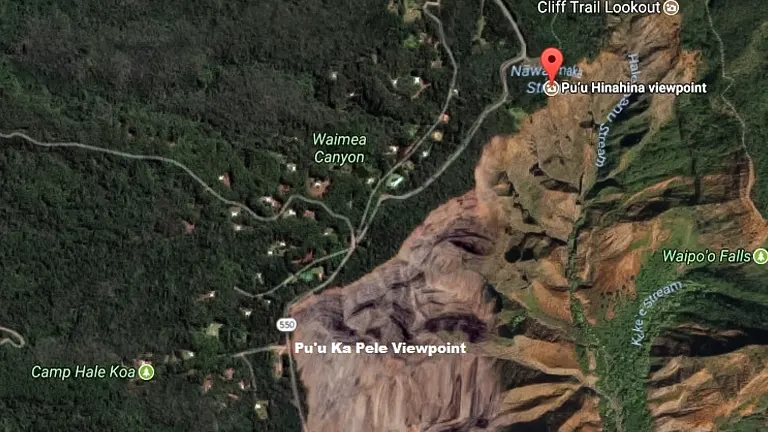
As visitors traverse the park, they not only witness the dramatic depths and vibrant colors of the canyon but also enjoy sweeping views of the neighboring island of Niʻihau. The park’s location at the confluence of diverse geological forces and its accessibility from the town of Waimea via the scenic Hawaii state road 550 make it a captivating destination, offering a front-row seat to the extraordinary natural beauty and geological history of Kauai.
Diverse Vegetation and Unique Plant Species:
- Ohia Lehua (Metrosideros polymorpha): Waimea Canyon State Park is adorned with the iconic ohia lehua, a native Hawaiian tree known for its vibrant red blossoms. Thriving in the park’s diverse elevations, the ohia lehua holds cultural significance in Hawaiian mythology and is often the first plant to colonize barren volcanic landscapes.
- Koa (Acacia koa): The majestic koa tree graces the park with its large, fern-like leaves and distinctive bark. As a native Hawaiian hardwood, koa plays a crucial role in the island’s ecosystems and has been historically utilized by the indigenous people for crafting canoes and tools.
- Naupaka (Scaevola): Along the canyon’s edges, the naupaka plant displays its distinctive half-flower, contributing to the park’s unique coastal flora. Legend has it that the naupaka flower symbolizes a love that remains incomplete, adding a touch of romance to the park’s botanical tapestry.
- Silversword (Argyroxiphium sandwicense): In the higher elevations of the park, the endemic silversword plant can be found, a striking sight with its silvery leaves clustered in a rosette. Endangered and unique to Hawaii, the silversword has adapted to the harsh alpine conditions over millennia.
- Iliau (Wilkesia gymnoxiphium): Endemic to Kauai, the iliau is a rare and endangered plant species that graces the park with its distinctive silver-gray leaves. Its survival is closely tied to the fragile ecosystems within the canyon, making it a symbol of the need for conservation efforts.
- Hapuu (Cibotium): The hapuu, or Hawaiian tree fern, adds a prehistoric charm to Waimea Canyon State Park. Often found in the park’s lush, shaded areas, these ferns have cultural significance and were historically used for thatching and as a staple in traditional Hawaiian medicine.
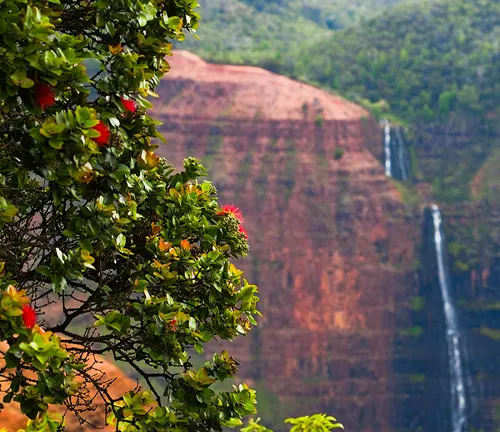
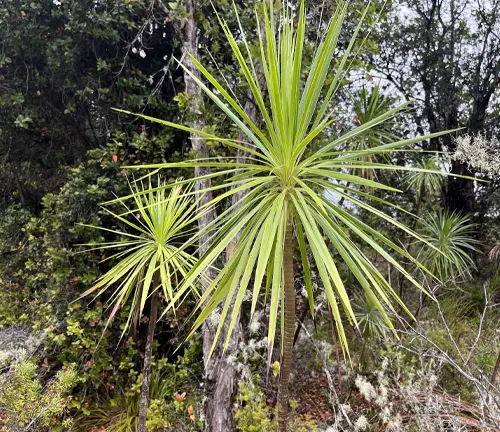
Fauna:
- Kauai Amakihi (Chlorodrepanis stejnegeri): The Kauai amakihi, a small native bird, adds a lively presence to Waimea Canyon State Park. Adapted to various elevations, this honeycreeper plays a crucial role in pollination and seed dispersal, contributing to the park’s ecological balance.
- Iiwi (Drepanis coccinea): With its vibrant scarlet plumage, the iiwi is another striking bird species found within the park. Endemic to Hawaii, this nectar-feeding bird adds both visual appeal and ecological importance as a pollinator to Waimea Canyon’s diverse plant life.
- Hawaiian Hawk (Buteo solitarius): The Hawaiian hawk, or ‘io, soars above the canyon, showcasing its prowess as a top predator in the park’s ecosystem. Revered in Hawaiian culture, the ‘io is a symbol of strength and vision, adding a touch of wild majesty to the park’s skies.
- Jackson’s Chameleon (Trioceros jacksonii): This non-native reptile has established a population in the park. Known for its distinctive horn-like projections, Jackson’s chameleon is an intriguing sight, although its introduction raises concerns about its impact on the park’s native fauna.
- Ae’o (Himantopus mexicanus knudseni): Also known as the Hawaiian stilt, the ae’o is a native bird species often spotted in the wetland areas of the park. Recognizable by its long legs and distinctive black-and-white plumage, the ae’o is an elegant inhabitant of the park’s diverse ecosystems.
- Hawaiian Moorhen (Gallinula chloropus sandvicensis): Found in the wetland habitats of Waimea Canyon State Park, the Hawaiian moorhen is a water bird endemic to the islands. Its presence reflects the importance of preserving the park’s wetland ecosystems for the benefit of native fauna.


Importance as a Wildlife Corridor and Habitat for Threatened Species
Waimea Canyon State Park stands as a vital wildlife corridor and a refuge for threatened species, embodying a cornerstone of conservation efforts on the island of Kauai. The park’s diverse landscapes, including dry upland forests and wetland habitats, create a natural thoroughfare that allows wildlife to navigate through varying elevations and ecological niches. Scientific studies, such as those conducted by the Hawaii Department of Land and Natural Resources, highlight the significance of these wildlife corridors in maintaining genetic diversity among populations.
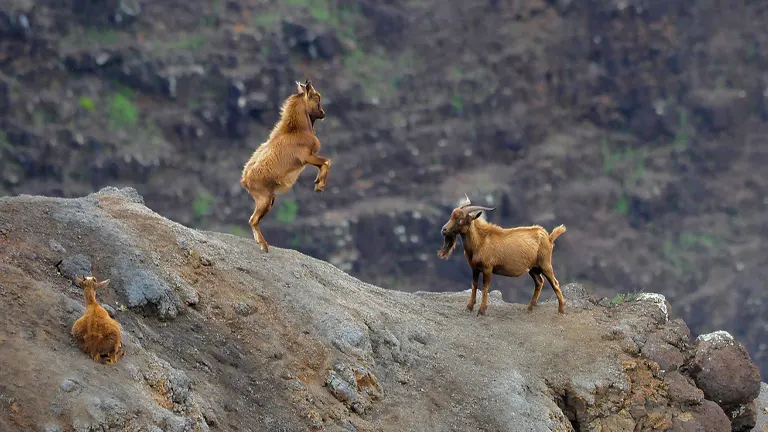
The park serves as a haven for threatened avian species like the Kauai amakihi, a small honeycreeper, and the Hawaiian hawk, locally known as ‘io. The ‘io, in particular, holds cultural importance and is recognized as an endangered species, making its preservation crucial. Additionally, ongoing research by the Kauai Forest Bird Recovery Project underscores the role of Waimea Canyon in providing essential habitat for these species. The wetland areas within the park support the Hawaiian moorhen, a water bird endemic to the islands and listed as a threatened species. As an interconnected sanctuary for these animals, Waimea Canyon State Park not only safeguards their habitats but also contributes significantly to broader conservation initiatives aimed at protecting Kauai’s fragile and endangered wildlife.
Activities in Waimea Canyon State Park for Visitors
1. Scenic Drives
One of the primary attractions in Waimea Canyon State Park is the opportunity for scenic drives. The park features Hawaii state road 550, an 18-mile-long route that offers breathtaking views of the canyon, lush landscapes, and distant vistas. Travelers can experience the changing colors and contours of the canyon from various lookout points along the way.
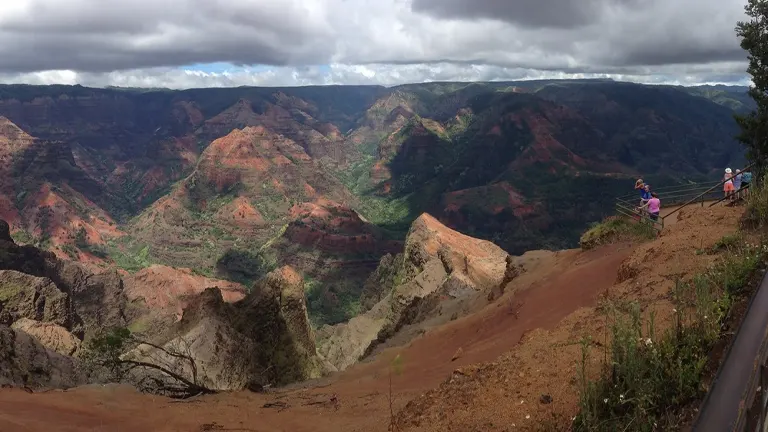
The scenic drive through Waimea Canyon allows visitors to comfortably explore the park’s grandeur. With conveniently located viewpoints, the drive caters to all visitors, providing a memorable and accessible introduction to the stunning landscapes.
2. Panoramic Lookouts
Waimea Canyon State Park boasts numerous panoramic lookout points, each offering a unique perspective of the canyon’s vast expanse. Popular viewpoints like Waimea Canyon Lookout and Pu’u Hinahina Lookout provide unparalleled vistas, allowing visitors to capture the beauty of the canyon from different angles.

The park’s strategically placed lookouts cater to both casual observers and avid photographers. These vantage points serve as natural platforms for visitors to immerse themselves in the breathtaking scenery, making the canyon’s grandeur accessible to all.
3. Hiking Trails
With an extensive network of hiking trails, Waimea Canyon State Park offers options for every level of hiker. Trails like the Canyon Trail and the Cliff Trail lead adventurers through diverse landscapes, providing opportunities to explore the canyon’s depths and witness its unique geological features.
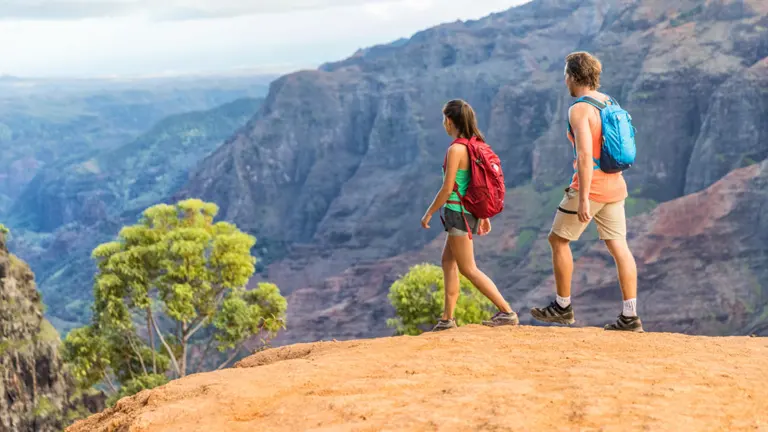
Hiking in Waimea Canyon allows visitors to go beyond the scenic viewpoints, offering a more immersive experience. Whether opting for a leisurely stroll or a challenging trek, hikers can connect with the park’s natural beauty and discover hidden gems along the way.
4. Biking Tours
For those seeking an active adventure, biking tours provide an exhilarating way to explore the park. Guided tours take cyclists through the canyon’s winding roads, allowing them to absorb the stunning scenery at a leisurely pace while enjoying the fresh mountain air.
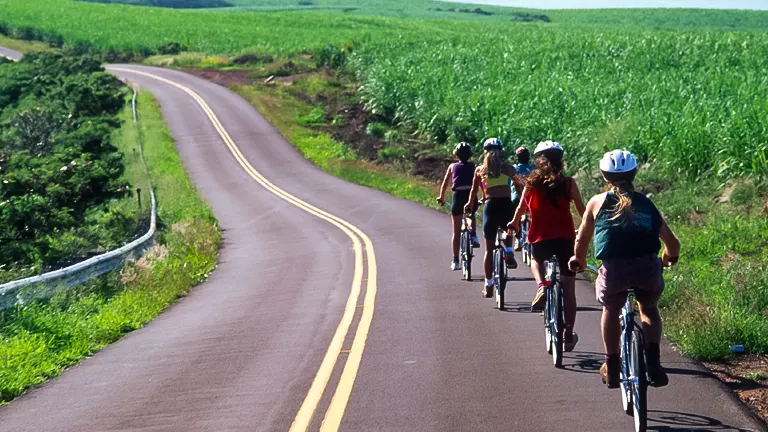
Biking tours offer a dynamic and engaging experience, allowing visitors to cover more ground than traditional walking. This activity caters to both nature enthusiasts and adventure seekers, combining physical activity with the beauty of Waimea Canyon.
5. Helicopter Rides
To witness Waimea Canyon from a truly unique perspective, helicopter rides are available for visitors. These aerial tours provide a bird’s-eye view of the canyon’s intricate formations, waterfalls, and lush landscapes, offering an unforgettable experience.

Helicopter rides add a touch of luxury and exclusivity to the visit, providing an unparalleled view of Waimea Canyon’s vastness. This activity is ideal for those looking to appreciate the grandeur of the canyon in a truly unique and memorable way.
Conservation and Management
The conservation and management of Waimea Canyon State Park are guided by a commitment to preserving its unique ecological and geological features while providing sustainable recreational opportunities for visitors. The Hawaii Division of State Parks oversees the management of the park, implementing strategies that balance conservation efforts with responsible tourism. Key aspects of the conservation and management plan include:
- Habitat Protection: The protection of diverse habitats within the park is a priority. Conservation efforts focus on minimizing disturbances to sensitive ecosystems, particularly those housing endemic and threatened plant and animal species. Strategies may include trail management, habitat restoration projects, and the implementation of protective measures in critical areas.
- Visitor Education: An essential component of park management is educating visitors about the significance of Waimea Canyon’s natural features and the importance of responsible behavior. Interpretive programs, informational signage, and visitor centers play a crucial role in conveying the park’s ecological and cultural value, promoting responsible recreation practices.
- Trail Maintenance: The extensive network of hiking trails is carefully maintained to balance accessibility with ecosystem protection. Regular trail maintenance ensures that visitors can enjoy a safe and enjoyable experience while minimizing the impact on the surrounding environment. Trail design and construction adhere to sustainable practices to prevent erosion and habitat disturbance.
- Invasive Species Control: Invasive plant and animal species pose a threat to the park’s native ecosystems. Management efforts include invasive species removal programs, monitoring, and collaboration with conservation organizations to mitigate the impact of non-native species on the park’s biodiversity.
- Cultural Preservation: Waimea Canyon State Park has cultural significance to the Native Hawaiian community. Management strategies incorporate cultural preservation by consulting with local communities, respecting sacred sites, and integrating traditional knowledge into conservation practices.
- Infrastructure Maintenance: The upkeep of park facilities, roads, and amenities is crucial for ensuring the safety and comfort of visitors. Regular maintenance and infrastructure improvements are undertaken to enhance the overall visitor experience while minimizing environmental impact.
- Research and Monitoring: Ongoing research and monitoring programs contribute to the understanding of the park’s ecosystems, wildlife, and geological formations. Scientific data guides conservation efforts and helps in adapting management strategies to evolving environmental conditions.
- Collaboration and Partnerships: Waimea Canyon State Park management collaborates with various stakeholders, including community groups, conservation organizations, and government agencies. Partnerships foster a collective approach to conservation, leveraging resources and expertise for the long-term well-being of the park.
- By implementing these conservation and management practices, Waimea Canyon State Park aims to strike a harmonious balance between preserving its natural and cultural heritage and providing a sustainable and enriching experience for present and future generations of visitors.
Recommendation
I highly recommend exploring Waimea Canyon State Park for a captivating blend of natural beauty and cultural significance. Featuring diverse ecosystems, unique landmarks, and a range of recreational opportunities, the park offers a distinctive and immersive adventure. Engage in responsible outdoor activities like hiking and wildlife observation while respecting ongoing conservation efforts. The scenic trails, historic sites, and collaborative conservation initiatives make Waimea Canyon State Park a must-visit destination for those seeking a harmonious combination of nature and recreation.
Conclusion
Waimea Canyon State Park, with its breathtaking landscapes and geological wonders, stands as a testament to the raw beauty of nature on the island of Kauai. From the vibrant hues of the canyon walls to the lush greenery and cascading waterfalls, every facet of the park tells a story shaped by millions of years of geological evolution. The diverse plant and animal life, some endemic and endangered, further enrich the park’s ecological tapestry. As visitors traverse the scenic drives, hike the trails, or embark on helicopter rides, they are not just witnesses to the grandeur of Waimea Canyon but participants in a dynamic conversation between humankind and the natural world. The park’s commitment to conservation, cultural preservation, and responsible tourism underscores its role as a guardian of Kauai’s unique heritage. Waimea Canyon State Park is not merely a destination; it is an invitation to connect with the profound forces that have shaped the island, fostering an appreciation for the delicate balance between preservation and exploration.
Encouraging Responsible Visitation
Contemplating my experience at Waimea Canyon State Park, I am motivated to advocate for mindful exploration. This ever-changing canyon landscape thrives when visitors engage responsibly. Whether you are an avid hiker, a photography enthusiast, or a family seeking a weekend retreat, every moment spent in Waimea Canyon State Park offers a chance to actively contribute to its conservation efforts.
FAQs
- Why does Waimea Canyon State Park boast such vibrant colors?
The canyon’s vivid hues are a result of the mineral-rich red soil, a product of ancient volcanic activity. Over time, weathering and erosion have exposed the vibrant spectrum of colors, making it a geological masterpiece. - Are there any rare birds to spot in Waimea Canyon State Park?
Indeed, the park is a haven for birdwatchers. Keep an eye out for the elusive pueo, or Hawaiian owl, soaring through the canyon skies, adding a touch of mystery to the landscape. - Can you encounter unique flora in Waimea Canyon State Park?
Absolutely. Look for the Kauai endemic mokihana tree, recognizable by its distinct green berries. The scent of these berries is said to be an ancient symbol of love and friendship among locals. - What’s the most unexpected feature in Waimea Canyon State Park?
Venture to the canyon’s west side to discover the peculiar “Black Pipe,” a mysterious formation that has puzzled geologists. Its origin remains a local curiosity and adds an element of intrigue to the park. - Are there any night tours or stargazing events in Waimea Canyon?
Yes, some local tour operators offer nighttime excursions. Experience the park under the celestial canopy, witnessing the stars above Waimea Canyon, which boasts remarkably clear skies for stargazing. - Can you explore hidden caves in Waimea Canyon State Park?
While not extensively advertised, some experienced guides offer off-the-beaten-path tours, allowing adventurous visitors to discover hidden caves and rock formations within the park. - What cultural rituals are associated with Waimea Canyon for the Hawaiian community?
Waimea Canyon holds a sacred place in Hawaiian mythology. Local legends recount stories of deities shaping the landscape, giving the canyon cultural significance as a realm where ancient spirits once roamed. - Are there any rare celestial events visible from Waimea Canyon State Park?
Waimea Canyon’s elevation and lack of light pollution make it an ideal spot for witnessing celestial events. Check local astronomy calendars for chances to witness phenomena like meteor showers and lunar eclipses.
As we conclude our exploration of Waimea Canyon State Park, it’s not merely a farewell but an invitation to carry the spirit of this natural marvel with you. Beyond the vibrant hues of the canyon walls and the whispers of Hawaiian legends, Waimea Canyon encapsulates an immersive journey through time and culture. As you venture forth, may the memories of scenic drives, encounters with rare wildlife, and the rich tapestry of flora linger, reminding you of the delicate dance between preservation and exploration. Until the next chapter unfolds, let Waimea Canyon’s timeless allure resonate, a testament to the boundless wonders that await those who seek solace and inspiration in the heart of Hawaii’s captivating landscapes.


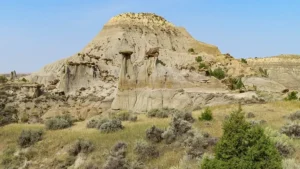

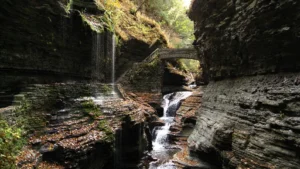
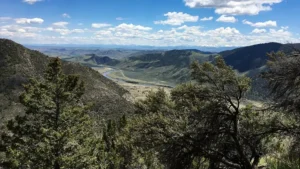

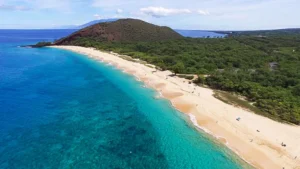
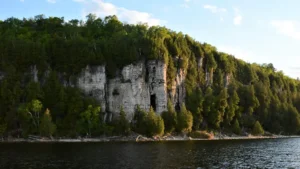
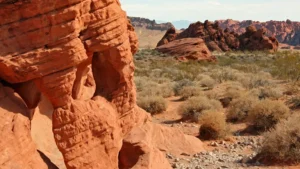
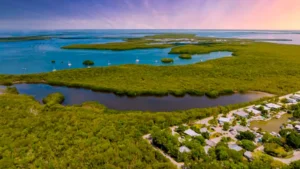
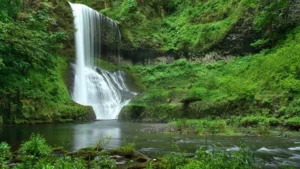
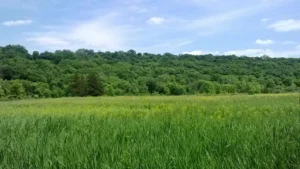

Leave your comment